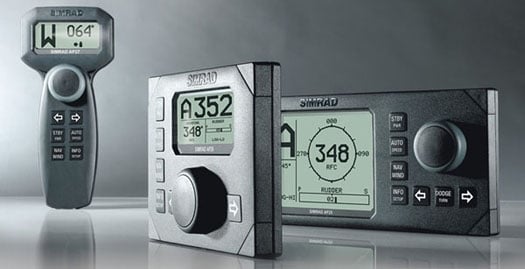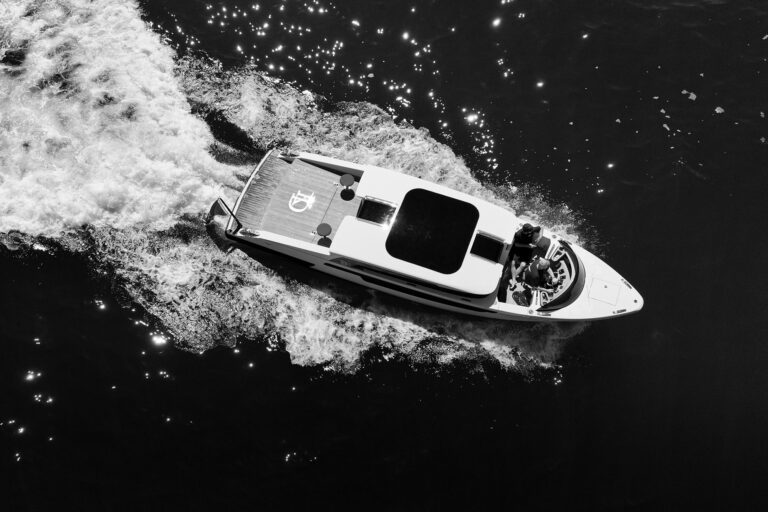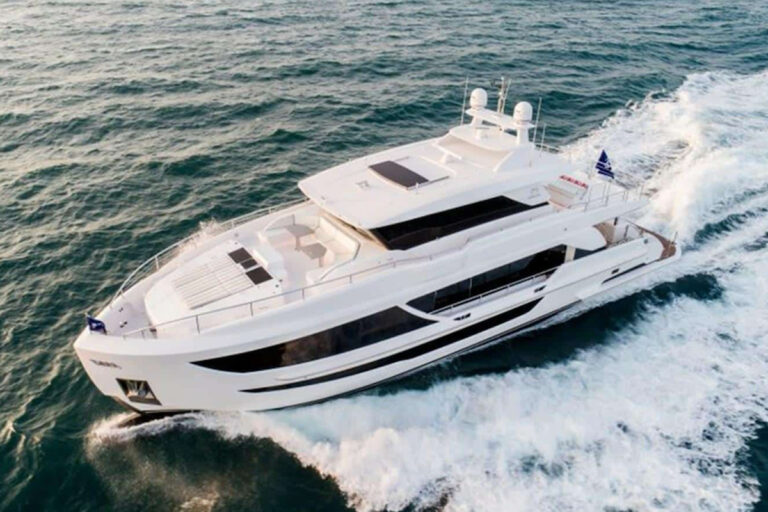
yachting/images/magazine/2006/122006/ele_electronics1_525x269.jpg
Autopilots make great crew. They work for a miserly amount of electrical energy, steer more precisely than you can and, by keeping your vessel on course, reduce fuel consumption. For years, guided by magnetic heading sensors with sensitivity to motion, autopilot performance was limited in other than calm-to-moderate sea conditions. Autopilots now use solid-state magnetic heading sensors. Supplemented by rate gyros with GPS compasses (or north-seeking ship’s gyroscopes), these improved sensors rely on control algorithms implemented via digital processors to maintain control even in demanding conditions.
Connected to a vessel’s GPS receiver/chart plotter, the autopilot accurately pilots the yacht on complex routes, automatically compensating for the influence of wind and current. Since energy is consumed every time the yacht’s rudder is moved, the autopilot keeps the vessel very close to the desired heading or course, resulting in small, energy-efficient rudder movements.
The basic operation of all autopilots is similar, yet they differ in the type of magnetic heading sensor they use, the presence or absence of rate gyros, use of rudder position sensors, type of control/display interface (simple or graphic) and availability of additional control stations. Some systems use fuzzy logic, acquiring information about the yacht as it is operated, learning and building an optimum set of response characteristics. Wired and wireless remote controls are increasingly popular, and when combined with engine- and gear-control functions can greatly simplify docking and undocking maneuvers.
Keep those thoughts in mind as you read ahead.
AutoNav A-1500 AutoNav produces the A-1500 and the A-1510. Both units provide a full range of functions, including auto deviation correction for their fluid-filled fluxgate compass, which can accommodate vessel heel angles of up to 45 degrees. Alternatively, gyrocompass information can be used to supply heading information. Up to four submersion-proof control stations can be used, including a portable remote control. Steering interface includes NMEA 0180 through 0183 and, with an additional module, wind-vane steering. The control heads have large LCD screens and backlighted four-key keypads. An optional PC interface allows computer control and monitoring of the autopilot’s performance. Dual outputs are available in the A-1500 for use with dynamic positioning systems, independent twin rudders and waterjets. www.autonav.com
B&G B&G, now a part of Simrad, manufacturers autopilots suitable for power and sailboats of 30 to over 300 feet in length. The H1000 systems are primarily used in power and sail boats up to about 40 feet overall. The LCD-equipped control/display unit provides a nine-key keypad plus a rotary course-setting knob. Remote, handheld controls include a joystick. The larger, H2000 (Hydra/Hercules) system is similar in design and construction, using a larger display/control. Large remote data displays of particular advantage on racing yachts are available in two sizes. Wind sensors are available for both pilots. www.bandg.com
ComNav ComNav’s autopilot range includes its most advanced unit, the ComPilot Admiral and Commander models, and four smaller units, the 1001 and 1101. The 1201 is designed specifically for workboat application and the 1420 for smaller recreational vessels. The 1420’s six-key waterproof control head can be mounted or handheld. The 1101 and companion 1201 pilots use identical backlit control/display units with large LCD data screens and are recommended for use on vessels between 30 and 60 feet overall. The 2001 and 5001 models are suitable for vessels between 80 and 500 feet in length and differ primarily in the type of control/display head used. The newest unit, the ComPilot features a 320 by 240 pixel high-contrast TFT LCD and incorporates ComNav’s Intelligent Steering Technology, a self-learning process that continually refines the pilot’s response to sea conditions and vessel dynamics. www.comnavmarine.com
Furuno Furuno offers the NavPilot 500, the model 511 and the handheld 520. All models employ the fuzzy logic introduced in the NavPilot 500. Fuzzy logic enables the autopilot to parallel the actions of a skilled helmsman new to a vessel by sensing the boat’s behavior under varying sea, wind, speed and load conditions and then using the knowledge to constantly improve its ability to steer smoothly and precisely. It operates in four modes: auto (fixed heading control); advanced auto (tracks a fixed path referenced to the ground via GPS data to eliminate effects of wind and current); nav (course determined by information from the GPS or chart plotter); and autowork (provides for permanent trim compensation). The 500’s rate gyro compass sensor assures good rudder control in the difficult following-sea conditions that can overcome many autopilots. Furuno’s GPS Satellite compass or a north-seeking ship’s gyrocompass can be used in place of the magnetic sensor. All three versions of the NavPilot are available in special outboard engine configuration. Up to six control stations can be used in any NavPilot installation. www.furunousa.com
Navman Navman’s autopilots include the G-Pilot 3100 and the G-Pilot 3380. The G-Pilot 3380 control head features a daylight-viewable 3.8-inch transflective color LCD and a large-diameter rotary control knob. Four keys, ESCAPE, ENTER, MENU and DISPLAY, provide access to the primary functions. PORT and STARBOARD DODGE keys initiate momentary deviations from the current course. The TURNS key accesses the turn library: tack/gybe, 90-degree and 180-degree turns. The remaining control keys consist of AUTO, MODE, STBY and POWER. Rotation of the control knob provides a 10-degree change in course per click or 30 degrees with a full turn. The system’s intuitive LCD shortens the learning process for new users. The G-Pilot 3100 uses a smaller control head equipped with a monochrome LCD and accomplishes all user interface commands with four keys. www.navman.com
Nautamatic Nautamatic’s TR-1 Gladiator is suitable for any hydraulically steered boat, including those powered with Mercury Verado outboards. The TR-1 Gold is designed for use with outboard engines between 6 hp and 20 hp. Both autopilots operate without the need for a rudder-position sensor. The patented Shadow Drive allows the helmsman to take control of steering without having to disengage the autopilot and to revert to automatic steering by terminating manual input. A rate-gyro-aided heading sensor is standard. Programmed maneuvers include circles, U-turns, orbit of waypoint, zig-zag, cloverleaf and search pattern with selectable distance increments. A wireless remote control is optional, and a new optional multi-function display provides current heading, steering mode, rate of turn and desired heading and rudder position (with the addition of a rudder position sensor). www.nautamatic.com
Raymarine Raymarine autopilots include tiller pilots and wheel pilots for sailboats, SmartPilots for Verado outboards and SmartPilots for inboard systems. Four tiller pilot models, the ST1000+, ST2000+, ST4000+ and ST4000+ Grand Prix cover boat displacements of 6600 to 16,500 pounds. All models can be interfaced with Raymarine’s LifeTag wireless man-overboard monitoring, and the optional S100, or SmartController, controls provide up to 10-meter wireless range and are optional for all pilots. The extensive SmartPilot inboard range includes the 6000 series 3-inch LCD-equipped control heads, ST6001 and the ST6002+ in both surface- and flush-mount versions, as well as the 7000 series, 4-inch LCD ST7001, and the new ST7002+ in both surface- and flush-mount styles, and the ST8000 series. Three electronic Corepacks are offered to match vessel displacements from 20,000 to 77,000 pounds, with the “G versions of the CorePacks adding a rate gyro to the magnetic flux detector to improve steering performance in difficult sea conditions. www.raymarine.com
Simrad Simrad’s autopilot products range from Cockpit Pilots (three Tillerpilots and a Wheelpilot), suitable for boats up to 18,700 pounds displacement, and extend upward to the AP50 and AP9Mk3, suitable for virtually any size yacht and capable of integrating the control of thrusters, making autopilot steering possible at unusually low speeds. The Wheelpilot and two of the Tillerpilots (TP-22 and TP-32) can be interfaced with the electronics needed to provide steer-to-wind or steer-to-waypoint. The AP12 and AP14 pilots are designed for vessels up to about 30 feet in length and include steer-to-heading (fluxgate compass) and steer-to-GPS. Versions are available for cable and hydraulic steering applications. The AP16 and AP25 series (AP25, 26, 27) use a common central computer module. All units provide a no-drift steering mode in which information from the boat’s GPS eliminates course deviations caused by wind and current, without having to set a go-to-waypoint. Installation with outboard engines is simplified with use of a Virtual Rudder Feedback system, which synthesizes the rudder position information; a special version is available for use with the Volvo Penta IPS drive system. The AP35 and AP50 models permit integration with gyrocompasses in addition to the usual fluxgate and can be connected to follow-up and non-follow-up steering levers. The AP50 model can use the Remote Commander control. The AP9Mk3 is the most capable of Simard’s autopilots and is suitable for use on virtually any yacht. www.simradyachting.com
Sperry Sperry Marine builds autopilots for mega-yachts and up. The Navipilot 4000 works through the ship’s steering network and automatically adjusts to changes in load, a valuable asset for megayachts in which the weight of fuel on board varies considerably. The Navipilot V HSC is designed specifically for high-speed craft, including hydroplanes and high-speed monohulls and catamarans. These big-ship autopilot systems can be integrated with a fiber-optic gyrocompass, a conventional north-seeking gyrocompass, a GPS satellite compass, a fluxgate or an electronic compass. www.sperrymarine.northropgrumman.com
Tecnautic Tecnautic, a Swiss/U.S. company known for its exclusively Internet-marketed programmable autopilots, has added a full-authority digital engine control with integrated fly-by-wire steering to its product line. The building-block design of the autopilots allows progressive installation of what can become a comprehensive autopilot/instrument system. Autopilot operating modes include “H heading, which follows a jet; “C, a track mode that combines information from the vessel’s GPS with magnetic heading to eliminate course deviations caused by wind or current; Wind, referenced to apparent or true wind; Nav, steer to waypoint; and Land, a precise GPS referenced steering mode usable at speeds below six knots when the GPS information resolution to three decimals is available, enabling the vessel to maintain a course within 0.001 nm, or approximately six feet. www.tecnautic.com
W-H Autopilots The W-H product line consists of three systems, the PC-3, AP-4 and the P-5, described as suitable for yachts and working boats up to 90 feet overall. All systems obtain heading information from magnetic fluxgate compasses with 45-degree internal gimbaling. The FG-100 heading sensor automatically compensates for local permanent magnetic fields, including symmetrical and asymmetrical soft iron. A new electronic steering wheel, the C-14, may become available as an option. www.whautopilots.com









